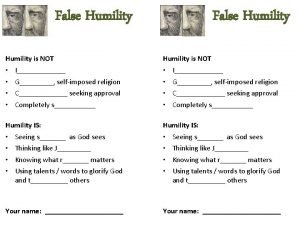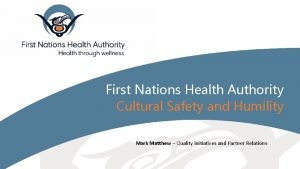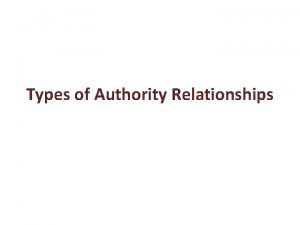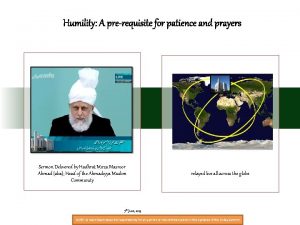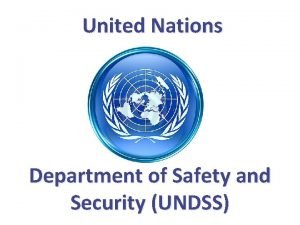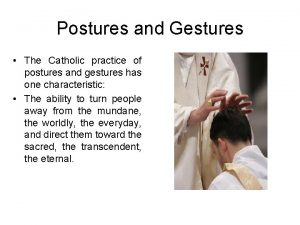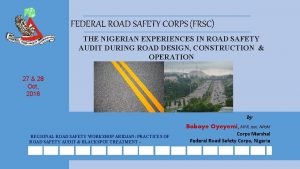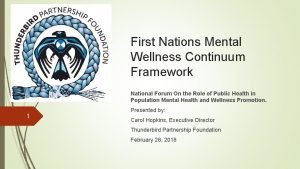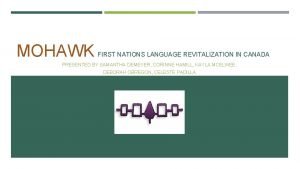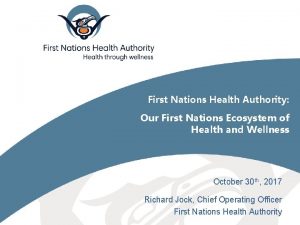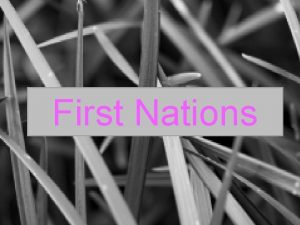First Nations Health Authority Cultural Safety and Humility

























- Slides: 25

First Nations Health Authority Cultural Safety and Humility Mark Matthew – Quality Initiatives and Partner Relations

“While Indigenous children were being mistreated in residential schools by being told they were heathen, savages and pagans and inferior people -- that same message was being delivered in the public schools of this country. ” Justice Murray Sinclair

Our History • 10, 000+ years • Economic systems • Education and training • Resource management • Leadership structures • Languages and cultures • Health and Wellness

Health and Wellness Interrupted • Our vision of health and wellness comes from the ancestors and is relational • Colonization interrupted this worldview

Imposition of Colonial Institutions & Systems The Indian Act, 1876 • Expropriation of land territory (creation of reserves) • Cultural genocide (removal of children, ceremonies and potlatches outlawed until 1951) • Denied access to Justice (denied voting rights, prohibited legal action until 1951) • Segregation (created reserves, Indian hospitals, Residential Schools, pass systems) • Imposition of foreign governance (eg. Band councils) • Undermining of Identity (status system) • Imposition of patriarchal approaches (status for women) • Undermining of self-determination (individual and collective)

Colonial Institutions & Systems Residential Schools St Paul’s Indian Residential School, North Vancouver BC Indian Hospitals Children in ‘care’ Coqualeetza Indian Hospital, Sardis BC Regina Leader-Post newspaper on Nov. 14, 1972 Justice System Alouette Correctional Centre for Women, Maple Ridge BC

Impact of Residential Schools In British Columbia, there were 21 residential schools mandated by the federal government and operated between 1861 until 1984. - Five remain standing Over the 135 years of residential schools across Canada: 150, 000 Aboriginal children were taken Estimated reported number of residential schools student deaths: Over 6, 000 Indian Residential School Survivors: 80, 000 (2015) Since 1941, 29 Indian Hospitals were federally run across Canada. (3 in BC).

“We are at a pivotal moment in our collective history, one where we have a unique opportunity to mature as a society. We are now entering a post-colonial era. This country is founded and built on a very solid foundation of Indigenous people. We will no longer be invisible in our own land. ” -Hereditary Chief Ian Campbell, Squamish Nation 8

What was the impetus for change? ns o i t a N t irs F g f n i o k s a u t m a ion h st s t i l c a e e d h and t c i n e m m o on lve c es o e u v s n s i o i i c n y t o o i i l S ua Nat q • t s d r i n F a ess ited c c m i A L ion t s a e r • c g i v e r t in Se f h o t l k a c e a l m • H tye i t c s a y p S a l e C C d all B r e t r a i P o f m i t L i BC f • / h d y t i o c o w n e g i p ta shi ffic o e n n n o I i s t e a i l c • Re oli p w e B N H I A FN ss e n i d a re s r e n t r e! • Pa m i t r u so ’ t I •

Questions/Discussion?

British Columbia First Nations 26 Cultural Groups 34 Languages Over 200 First Nations (or Indian Bands) • 41 communities are either rural or rural/remote • ~57% live away from home Three Provincial First Nations Organizations • BC Assembly of First Nations • First Nations Summit • Union of BC Indian Chiefs

Relationships - Amongst Ourselves & with our Partners First Nations consensus-based, collective decision-making. Process of Nation-rebuilding through collective governance. “The health & wellbeing of my people depends on how well I work with each & every one of you in this room. ” -Chief Douglas White III Kwulasuitun

Our Common Foundation Shared Vision Healthy, self-determining and vibrant, BC First Nations children, families and communities Shared Values • • • Respect Discipline Relationships Culture Excellence Fairness 7 Directives 1. Community Driven, Nation Based 2. Increase First Nations Decision-Making 3. Improve Services 4. Foster Meaningful Collaboration and Partnerships 5. Develop Human and Economic Capacity 6. Be without Prejudice to First Nations Interests 7. Function at a High Operational Standard

First Nations Perspective on Health & Wellness • Wellness belongs to every human being and their reflection of this perspective will be unique • The FNHA through its services or partnership works to support BC First Nations on their wellness journey • Acknowledging that personal health and wellness is impacted by the world around them


Questions/Discussion?

FNHA Definitions of Cultural Safety and Humility Cultural Humility • Cultural humility is a process of self-reflection to understand personal and systemic biases and to develop and maintain respectful processes and relationships based on mutual trust. Cultural humility involves humbly acknowledging oneself as a learner when it comes to understanding another’s experience. Cultural Safety • Cultural safety is an outcome based on respectful engagement that recognizes and strives to address power imbalances inherent in the healthcare system. It results in an environment free of racism and discrimination, where people feel safe when receiving health care.

Core Concepts Racism: Prejudice, discrimination, or antagonism directed against someone of a different race based on the belief that one's own race is superior Institutional racism or systemic racism: Racism embedded into political and social institutions, leading to ‘hardwired’ discrimination, deliberately or indirectly, against certain groups of people which limits their rights.

Approach to Change – Initiatives |Tools | Resources • Creating a Climate for Change Resource Booklet • Partner Declarations of Cultural Safety and Humility • FNHA’s Policy Statement on Cultural Safety and Humility • Key Drivers and Ideas for Change • #itstartswithme Campaign • 10+ Cultural Safety and Cultural Humility Webinars • Website: http: //www. fnha. ca/wellness/culturalhumility

Hardwiring Cultural Safety & Humility into BC Health Services With accountability to First Nations ü ü ü ü Ministry of Health Ministry of Mental Health & Addictions First Nations Health Authority 5 Regional Health Authorities 1 Provincial Health Services Authority 20+Regulatory Bodies and Colleges Health system partners Health Canada/Public Health Agency of Canada/Indigenous Services Canada q Health System Associations q Academic Institutions And we will know that we’ve achieved cultural safety when the voice of the people receiving our services tells us we have. – FNHA’s vision for Cultural Safety & Humility

Cultural Safety and Humility – What’s Next? • Leadership space and momentum has been created in BC continue to spread across the country • Implement systemic action • System-wide reporting and measurement • Change leadership strategy • Organizational assessment tools • Critical incident response & complaints management • Training and education • Policy review and change • Physical space improvements • Building tools and curriculum • Toolkits for local knowledge and planning • Multi-media approaches • Continued commitment to #itstartswithme campaign • Cultural Safety and Humility Standard

Questions/Discussion?

Engaging with First Nations Take time to build relationship – trusted hand introduction • Consider partnering Define what ‘engagement’ means to your audience • IAP 2 is helpful (caution regarding Consultation/Empowerment) • What will be the impact of results? • How will it benefit them? Patient, Family, Caregiver and Public Engagement Planning Guide 2018 • Ensure maximum foresight as to the impact of the engagement – be meaningful • Do your homework on First Nations lived experience generally and locally – be prepared • If you’re not sure, ask for help and guidance from someone familiar with the community/location – be humble • Requesting an Elder opening is not a tick box activity - be respectful of their time 23


Questions/Discussion www. fnha. ca 25
 Humility meaning
Humility meaning Fnha cultural safety and humility
Fnha cultural safety and humility Cultural humility definition
Cultural humility definition Erika carr
Erika carr Trans umbrella
Trans umbrella Authority relationships
Authority relationships Proverbs on pride and humility
Proverbs on pride and humility Patience sermon outline
Patience sermon outline United nations department of safety and security
United nations department of safety and security Humility in bible means
Humility in bible means What knee do you genuflect on
What knee do you genuflect on Clothe yourselves with humility
Clothe yourselves with humility Unity through humility
Unity through humility Out of the heart flows the issues of life
Out of the heart flows the issues of life Philippians 2:1-30
Philippians 2:1-30 Highly capable individual
Highly capable individual Approved
Approved Biosphere 2 a lesson in humility
Biosphere 2 a lesson in humility Functions of federal road safety corps
Functions of federal road safety corps First nations
First nations Colours of medicine wheel
Colours of medicine wheel First nations launch
First nations launch First nations attack fort michilimackinac 1763
First nations attack fort michilimackinac 1763 Aboriginal simple machines
Aboriginal simple machines Fneaa
Fneaa Language
Language
